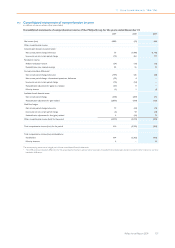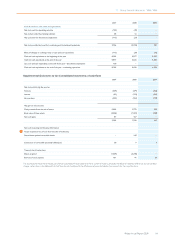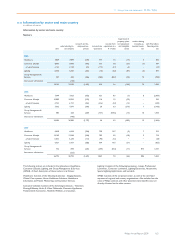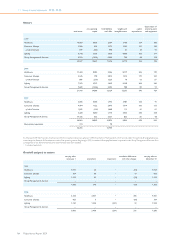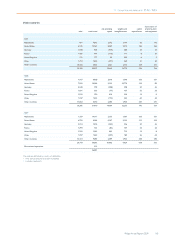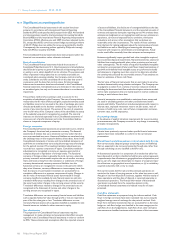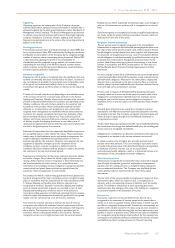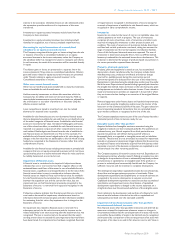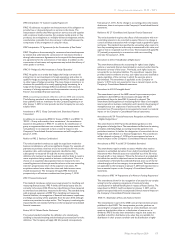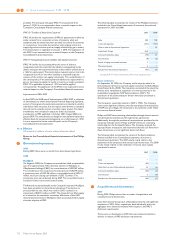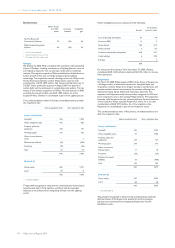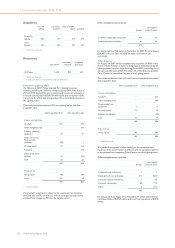Philips 2009 Annual Report Download - page 167
Download and view the complete annual report
Please find page 167 of the 2009 Philips annual report below. You can navigate through the pages in the report by either clicking on the pages listed below, or by using the keyword search tool below to find specific information within the annual report.
Segments
Operating segments are components of the Company’s business
activities about which separate financial information is available that is
evaluated regularly by the chief operating decision maker (the Board of
Management of the Company). The Board of Management decides how
to allocate resources and assesses performance. Reportable segments
comprise: Healthcare, Consumer Lifestyle, Lighting, and Television.
Segment accounting policies are the same as the accounting policies as
applied to the Group.
Earnings per share
The Company presents basic and diluted earnings per share (EPS) data
for its common shares. Basic EPS is calculated by dividing the net income
attributable to shareholders of the Company by the weighted average
number of common shares outstanding during the period. Diluted EPS
is determined by adjusting the profit or loss attributable to
shareholders and the weighted average number of common shares
outstanding for the effects of all dilutive potential common shares,
which comprise convertible personnel debentures, restricted shares
and share options granted to employees.
Revenue recognition
Revenue for sale of goods is recognized when the significant risks and
rewards of ownership have been transferred to the buyer, recovery of
the consideration is probable, the associated costs and possible return
of the goods can be estimated reliably, there is no continuing
involvement with goods, and the amount of revenue can be measured
reliably.
Transfer of risks and rewards varies depending on the individual terms
of the contract of sale. For consumer-type products in the Sectors
Lighting and Consumer Lifestyle, these criteria are met at the time the
product is shipped and delivered to the customer and, depending on the
delivery conditions, title and risk have passed to the customer and
acceptance of the product, when contractually required, has been
obtained, or, in cases where such acceptance is not contractually
required, when management has established that all aforementioned
conditions for revenue recognition have been met. Examples of the
above-mentioned delivery conditions are ‘Free on Board point of
delivery’ and ‘Costs, Insurance Paid point of delivery’, where the point
of delivery may be the shipping warehouse or any other point of
destination as agreed in the contract with the customer and where title
and risk in the goods pass to the customer.
Revenues of transactions that have separately identifiable components
are recognized based on their relative fair values. These transactions
mainly occur in the Healthcare sector and include arrangements that
require subsequent installation and training activities in order to
become operable for the customer. However, since payment for the
equipment is typically contingent upon the completion of the
installation process, revenue recognition is deferred until the
installation has been completed and the product is ready to be used by
the customer in the way contractually agreed.
Revenues are recorded net of sales taxes, customer discounts, rebates
and similar charges. For products for which a right of return exists
during a defined period, revenue recognition is determined based on
the historical pattern of actual returns, or in cases where such
information is not available, revenue recognition is postponed until the
return period has lapsed. Return policies are typically based on
customary return arrangements in local markets.
For products for which a residual value guarantee has been granted or a
buy-back arrangement has been concluded, revenue recognition takes
place in accordance with the requirements for lease accounting of IAS
17 Leases. Shipping and handling costs billed to customers are
recognized as revenues. Expenses incurred for shipping and handling
costs of internal movements of goods are recorded as cost of sales.
Shipping and handling costs related to sales to third parties are
recorded as selling expenses and disclosed separately. Service revenue
related to repair and maintenance activities for goods sold is recognized
ratably over the service period or as services are rendered.
A provision for product warranty is made at the time of revenue
recognition and reflects the estimated costs of replacement and free-
of-charge services that will be incurred by the Company with respect to
the products. The customer has the option to purchase such an
extension, which is subsequently billed to the customer. Revenue
recognition occurs on a straight-line basis over the contract period.
Royalty income, which is generally earned based upon a percentage of
sales or a fixed amount per product sold, is recognized on an accrual
basis.
Government grants are recognized as income as qualified expenditures
are made, except for grants relating to purchases of assets, which are
deducted from the cost of the assets.
Employee benefit accounting
The net pension asset or liability recognized in the Consolidated
balance sheet in respect of defined-benefit postemployment plans is the
fair value of plan assets less the present value of the projected defined-
benefit obligation at the balance sheet date, together with adjustments
for projected unrecognized past-service costs. The projected defined-
benefit obligation is calculated annually by qualified actuaries using the
projected unit credit method. Recognized assets are limited to the
present value of any reductions in future contributions or any future
refunds, in accordance with IFRIC Interpretation 14 ‘The Limit on a
Defined Benefit Asset, Minimum Funding Requirements and their
Interaction’.
For the Company’s major plans, a full discount rate curve of high-quality
corporate bonds (Bloomberg AA Composite) is used to determine the
defined-benefit obligation, whereas for the other plans a single-point
discount rate is used based on the plan’s maturity. Plans in countries
without a deep corporate bond market use a discount rate based on the
local sovereign curve and the plan’s maturity.
Pension costs in respect of defined-benefit postemployment plans
primarily represent the increase of the actuarial present value of the
obligation for postemployment benefits based on employee service
during the year and the interest on this obligation in respect of
employee service in previous years, net of the expected return on plan
assets.
Actuarial gains and losses arise mainly from changes in actuarial
assumptions and differences between actuarial assumptions and what
has actually occurred. The Company recognizes all actuarial gains and
losses directly in equity through the Consolidated statements of
comprehensive income.
To the extent that postemployment benefits vest immediately following
the introduction of a change to a defined-benefit plan, the resulting past
service costs are recognized immediately.
Obligations for contributions to defined-contribution pension plans are
recognized as an expense in the income statement as incurred.
In certain countries, the Company also provides postretirement
benefits other than pensions. The costs relating to such plans consist
primarily of the present value of the benefits attributed on an equal basis
to each year of service, interest cost on the accumulated
postretirement benefit obligation, which is a discounted amount, and
amortization of the unrecognized transition obligation.
Share-based payment
The Company recognizes the estimated fair value, measured as of grant
date of equity instruments granted to employees as compensation
expense over the vesting period on a straight-line basis, taking into
account expected forfeitures. The Company uses the Black-Scholes
option-pricing model to determine the fair value of the equity
instruments.
The fair value of the amount payable to employees in respect of share
appreciation rights, which are settled in cash, is recognized as an
expense, with a corresponding increase in liabilities, over the vesting
period. The liability is remeasured at each reporting date and at
settlement date. Any changes in fair value of the liability are recognized
as personnel expense in the Statement of income.
Income tax
Income tax comprises current and deferred tax. Income tax is
recognized in the statement of income except to the extent that it
relates to an item recognized directly within equity, in which case the
tax effect is recognized in equity as well. Current tax is the expected tax
payable on the taxable income for the year, using tax rates enacted or
substantially enacted at the reporting date, and any adjustment to tax
payable in respect of previous years. Deferred tax assets and liabilities
are recognized, using the balance sheet method, for the expected tax
consequences of temporary differences between the tax base of assets
and liabilities and their carrying amounts for financial reporting
11 Group financial statements 11.11 - 11.11
Philips Annual Report 2009 167


